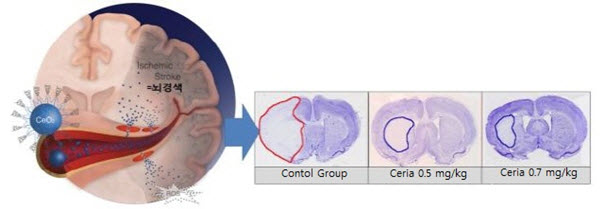 The joint research team led by Chair Professor HYEON Taeghwan of SNU’s Dept. of Chemical and Biological Engineering and Professor LEE Seung Hoon of the College of Medicine has succeeded in developing a new cure for ischemic stroke.[1]
The joint research team led by Chair Professor HYEON Taeghwan of SNU’s Dept. of Chemical and Biological Engineering and Professor LEE Seung Hoon of the College of Medicine has succeeded in developing a new cure for ischemic stroke.[1]
Professor Hyeon, Director of the Institute for Basic Science (IBS)’s Center for Nanoparticle Research, and Professor Lee cooperated to produce 3nm nanoparticles using ceria, a rare earth element. The nanoparticles were encapsulated with phospholipid[2]-polyethyleneglycol[3] (PEG). They found that the seceria nanoparticles reduced the damage of cerebral infarction in a living body by antioxidative[4] and antiapoptosis[5] activity.
Ischemic stroke is the most frequent cause of death following cancer, and it is the most lethal single disease in Korea. In addition, the disease causes severe aftereffects and entails huge costs, thus burdening patients’ families and the society. Nevertheless, no neuroprotective therapy for ischemic stroke exists that has passed clinical tests except clot-dissolving drugs (or clotbusters). Furthermore, various tests around the globe over the past few decades failed to develop a sustainable new cure until this research conducted by Professor Hyeon and Professor Lee this year.
 When the ceria nanoparticles laminated with polyethylene glycol (to increase biocompatibility) were administered intravenously, there was an approximate 50% reduction in the infected area.
When the ceria nanoparticles laminated with polyethylene glycol (to increase biocompatibility) were administered intravenously, there was an approximate 50% reduction in the infected area.
Ceria becomes an anti-oxidant if it is made intoa small nanoparticle. This is because cerium exists as Ce4+ on the surface of normal ceria crystals, but as Ce3+ on nanoparticle ceria crystals. Cerium generally reduces oxygen free radicals[6], and when it becomes Ce3+ this effect is drastically increased. This is why ceria nanoparticlesare used as an antioxidative catalyst in chemical processes.
The research team produced the unprecedented 3nm sized ceria nanoparticles to make them operative in a living body, and possess high anti-oxidative ability. Then they laminated PEG on the surface of ceria nanoparticles to make them run more smoothly through blood or organs.
The research team conducted a number of animal experiments on three groups of animals. After inducing ischemic stroke in animals, they injected 0.5 mg/kg and 0.7 mg/kg of ceria nanoparticles into the animals of two of the groups and nothing into the animals of the control group. As a result, the infarct volumes decreased 44.6% in the 0.5 mg/kg induced group and 50.2% in the 0.7 mg/kg induced group. In comparison, no change was observed in the control group. Ceria nanoparticles could not penetrate the blood brain barrier (BBB)[7] in undamaged brain tissue, and were minimally distributed when injected intravenously.
However, ceria nanoparticleswere distributed to a greater extent in the infarcted area due to the damage on the blood brain barrier. This caused a reduction in post-infarcted oxygen free radicals, and also reduced apoptosis, which is the main cause of major organ damage.
“Despite its high disease burden, no effective cure existed for cerebral infarction.We employed cutting-edge nanotechnology to produce ceria nanoparticles and encapsulated them with phospholipid-PEG to increase the possibility of a new cure for cerebral infarction,” said Professor LEE, who is also a practicing physician in the Department of Neurology of SNU Hospital. However, he added that this result came from experiments using animals and that in-depth research needs to follow in order to apply the ceria nanoparticles to use in humans.
The results of this research will be published in the globally renowned academic journal Angewandte Chemie International Edition, and have already been published on the journal’s website as of September 12 of this year. The paper was nominated for the journal’s “Very Important Paper” accolade, an honor which is only bestowed upon the top 5% of the journal’s papers. Angewandte Chemie also disseminated a press release about this research to foreign media.
[Additional definitions]
1. Ischemic Stroke: A cerebrovascular disorder caused by deprivation of blood flow to an area of the brain, generally as a result of thrombosis, embolism, or reduced blood pressure. Various neurological symptoms such as paralysis, neurological damage, and lalopathy occur and might leave sequelae.
2. Phospholipids: Amphipathic compounds with a ‘head’ that is hydrophilic and a lipophilic ‘tail’ that is hydrophobic. They serve as a major structural component of most biological membranes. They form the lipid bilayer in cell membranes or organisms.
3. Polyethylene Glycol (PEG): A generic name for mixtures of condensation polymers of ethylene oxide and water. Some are used as pharmaceutical aids.
4. Anti-oxidative:Having the ability to prevent or delay deterioration from oxidation caused by the oxygen in the air.
5. Apoptosis: The process of programmed cell death (PCD) in multicellular organisms. Cell shrinkage causes fissure between cells and chromosomal DNA fragmentation occurs inside cells. The cell dies when nearby phagocytes engulf the apoptotic bodies.
6. Oxygen Free Radicals: Reactive molecules that contain oxygen and can cause cell damage.
7. Blood Brain Barrier (BBB): The selective barrier separating blood from the parenchyma of the central nervous system.
Written by KIM Kyuho, SNU English Editor, dkrxmr@snu.ac.kr
Reviewed by Eli Park Sorensen, SNU Professor of Liberal Studies, eps7257@snu.ac.kr
Proofread by Brett Johnson, SNU English Editor, morningcalm2@gmail.com

